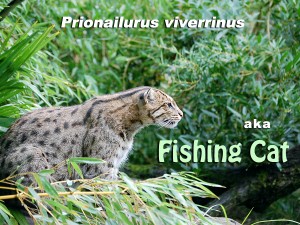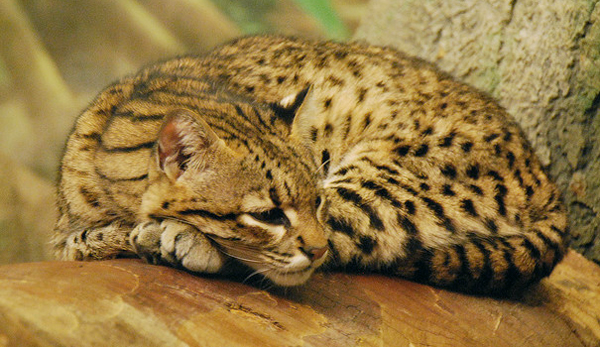By Alex Reshanov
Oct 01, 2014

Boldly going where few cats have gone before: into the water. As a teenager, I volunteered at the local animal shelter. One of the tasks I performed there was assisting in the bathing of newly acquired cats and kittens. From this I learned two important pieces of information: 1) cats hate water and 2) they will gladly claw your face off to escape a bath. Many wild felines also display a lack of enthusiasm for getting wet, but not the fishing cat. This species regularly and willingly enters water. They swim, they dive and, most importantly, they catch fish – thus earning them their common name.
Spots and stripes

Image Credit: cliff1066™.
The fishing cat’s partially webbed feet are sometimes cited as an adaptation to its aquatic lifestyle, but such webbing is also common in cats that eschew water. More unusual are the cat’s claws. The claws of most felines are fully retracted into their paws when not in use. But fishing cats’ claws are only partially sheathed and protrude from their paws like exposed fishing hooks.
The cats’ vocalizations are also a bit of an oddity. While the repertoire includes some cat-like meows, fishing cats also produce staccato growling sounds that might best be described as barks.

Fishing catnap. Image credit: bobosh_t.
 As you likely surmised, fishing cats are quite comfortable in the
water.* They’re skilled swimmers, even in deep water and for longer
distances. Their short tail can be used as a rudder for better steering.
As you likely surmised, fishing cats are quite comfortable in the
water.* They’re skilled swimmers, even in deep water and for longer
distances. Their short tail can be used as a rudder for better steering.
Image Credit: cliff1066™.
On the waterfront
Fishing cats are found in southern and southeastern Asia – including parts of India, Sri Lanka, Thailand and Indonesia – but their distribution is patchy. They live primarily near wetlands, slow moving bodies of water such as swamps and marshes being their optimum habitat.
The degradation of wetlands is the major threat to fishing cat populations. Human draining of these habitats for use in food production such as farm-raising of shrimp is swallowing large swathes of the cats’ terrain.
Fishing cats are listed as endangered, and conservationists are working to protect the cats and the wetlands they need to live and hunt. One piece of good news is that fishing cats inhabit some of the same environments as tigers, so conservation efforts on behalf of this larger, more famous feline may also benefit the fishing cat.
* Several other species of wild cats also defy the stereotype the felines can’t stand water. Tigers are the most well known of the swimming kitties.
source

No comments:
Post a Comment